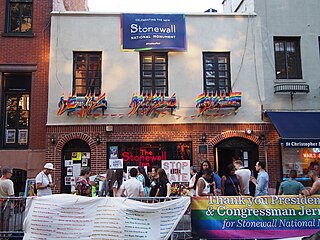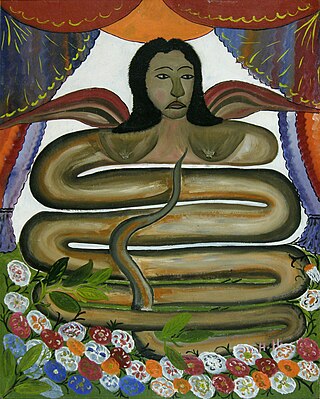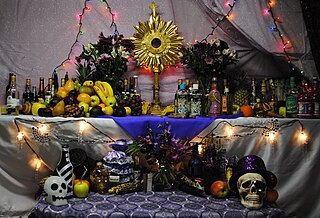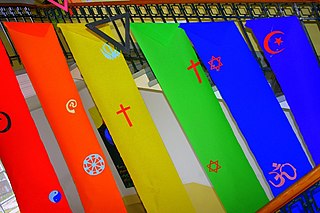
Lesbian, gay, bisexual, transgender and queer (LGBTQ) movements are social movements that advocate for LGBTQ people in society. Although there is not a primary or an overarching central organization that represents all LGBTQ people and their interests, numerous LGBT rights organizations are active worldwide. The first organization to promote LGBT rights was the Scientific-Humanitarian Committee, founded in 1897 in Berlin.

Lwa, also called loa, are spirits in the African diasporic religion of Haitian Vodou and Dominican Vudú. They have also been incorporated into some revivalist forms of Louisiana Voodoo. Many of the lwa derive their identities in part from deities venerated in the traditional religions of West Africa, especially those of the Fon and Yoruba.

Baron Samedi, also written Baron Samdi, Bawon Samedi or Bawon Sanmdi, is one of the lwa of Haitian Vodou. He is a lwa of the dead, along with Baron's numerous other incarnations Baron Cimetière, Baron La Croix and Baron Criminel.
The Gede are the family of lwa, spirits or deities associated with Ancestor worship in Haitian Vodou, that represent the powers of death and fertility. They are often said to be found at burial sites, where they escort the deceased to their afterlife. Gede spirits include Gede Doub, Guede-Linto, Guede L'Orage, Guede Oussou, Guede Nibo and Guede Masaka, and Guede Ti Malice. All are known for the drum rhythm and dance called the "banda". In possession, they will drink or rub themselves with a mixture of clairin and twenty-one scotch bonnet or goat peppers. Fèt Gede is celebrated on 2 November, All Souls' Day. Boons granted by the Gede not repaid by this date will be avenged afterwards.

Maman Brigitte sometimes also written as Manman Brigitte and also known by Gran Brigitte, Grann Brigitte, Manman, Manman Brigit, and Maman Brijit is a death loa and the consort of Baron Samedi in Haitian Vodou. She drinks rum infused with hot peppers and is symbolized by a black rooster. Maman Brigitte protects graves in Haitian cemeteries that are marked by the cross of Baron Samedi. Graves that are protected by Brigitte are marked by a mound of stones. In Vodou practice, the first burials serve as offerings to either Baron Samedi or Maman Brigitte depending on the gender of the person being laid to rest. If the deceased person is male then the grave is dedicated to Baron Samedi; if the deceased person is female then the grave is dedicated to Maman Brigitte.

Erzulie is a family of loa, or spirits, in Vodou.
Haitian mythology consists of many folklore stories from different time periods, involving sacred dance and deities, all the way to Vodou. Haitian Vodou is a syncretic mixture of Roman Catholic rituals developed during the French colonial period, based on traditional African beliefs, with roots in Dahomey, Kongo and Yoruba traditions, and folkloric influence from the indigenous Taino peoples of Haiti. The lwa, or spirits with whom Vodou adherents work and practice, are not gods but servants of the Supreme Creator Bondye. A lot of the Iwa identities come from deities formed in the West African traditional regions, especially the Fon and Yoruba. In keeping with the French-Catholic influence of the faith, Vodou practioneers are for the most part monotheists, believing that the lwa are great and powerful forces in the world with whom humans interact and vice versa, resulting in a symbiotic relationship intended to bring both humans and the lwa back to Bondye. "Vodou is a religious practice, a faith that points toward an intimate knowledge of God, and offers its practitioners a means to come into communion with the Divine, through an ever evolving paradigm of dance, song and prayers."

Homosexuality in Haitian Vodou is religiously acceptable and homosexuals are allowed to participate in all religious activities. However, in West African countries with major conservative Christian and Islamic views on LGBTQ people, the attitudes towards them may be less tolerant if not openly hostile and these influences are reflected in African diaspora religions following Atlantic slave trade which includes Haitian Vodou.

LGBTQ themes in horror fiction refers to sexuality in horror fiction that can often focus on LGBTQ+ characters and themes within various forms of media. It may deal with characters who are coded as or who are openly LGBTQ+, or it may deal with themes or plots that are specific to gender and sexual minorities.
Gede Nibo is a lwa who is leader of the spirits of the dead in Haitian Vodou. Formerly human, Gede Nibo was a handsome young man who was killed violently. After death, he was adopted as a lwa by Baron Samedi and Maman Brigitte. He is envisioned as an effeminate, nasal dandy. Nibo wears a black riding coat or drag. When he inhabits humans they are inspired to lascivious sexuality of all kinds.

LGBT themes in mythology occur in mythologies and religious narratives that include stories of romantic affection or sexuality between figures of the same sex or that feature divine actions that result in changes in gender. These myths are considered by some modern queer scholars to be forms of lesbian, gay, bisexual, or transgender (LGBT) expression, and modern conceptions of sexuality and gender have been retroactively applied to them. Many mythologies ascribe homosexuality and gender fluidity in humans to the action of gods or of other supernatural interventions.

In Ancient Greek religion and mythology, the Erotes are a collective of winged gods associated with love and sexual intercourse. They are part of Aphrodite's retinue. Erotes is the plural of Eros, who as a singular deity has a more complex mythology.
Greco-Roman mythology features male homosexuality in many of the constituent myths. In addition, there are instances of cross-dressing, androgyny, and other themes which are grouped under the acronym LGBTQ+.
Chinese mythology has been described as "rich in stories about homosexuality", reflecting ancient Chinese perspectives toward variance in sexuality and gender, rather than modern views. Chinese myths and traditional folk tales are greatly influenced by religious beliefs, particularly Taoist, Confucian, and Buddhist teachings.

The relationship between religion and lesbian, gay, bisexual, transgender and queer (LGBTQ) people can vary greatly across time and place, within and between different religions and sects, and regarding different forms of homosexuality, bisexuality, non-binary, and transgender identities. More generally, the relationship between religion and sexuality ranges widely among and within them, from giving sex and sexuality a rather negative connotation to believing that sex is the highest expression of the divine.

In Hindu mythology, there are deities or heroes whose attributes or behavior can be interpreted as lesbian, gay, bisexual, or transgender (LGBTQ) or have elements of gender variance and non-heterosexual sexuality. Traditional Hindu literary sources do not speak of homosexuality directly, but changes of sex, homoerotic encounters, and intersex or third gender characters are often found both in traditional religious narratives such as the Vedas, Mahabharata, Ramayana and Puranas as well as in regional folklore.

The following outline offers an overview and guide to LGBTQ topics:

Inle is the orisha of health and all medicinal healing in Santeria, and also in Candomblé and Palo Mayombe. Inle, also known as Erinle, is an Orisha who is associated with the estuary, an in-between space where the freshwater river meets the salty sea. He is the deity of health and medicine, the physician to other deities, hunter of the land and sea, and is often regarded as the patron of homosexual and transgender people. According to Yoruba tradition, Inle was a mighty hunter who became deified. He is also syncretized with the Archangel Raphael, whose name signifies "God heals." Raphael is frequently shown with fish, wearing blue and pink, and is the patron of nurses, doctors, and other medical workers.
A mudoko dako is an effeminate male who is considered by Langi society to be a different gender, though were mostly treated as woman among the Langi in Uganda. Mudoko dako also could be found among the Teso and the Karamojan people. Recognition of the mudoko dako can be traced back prior to colonialism in Africa.












